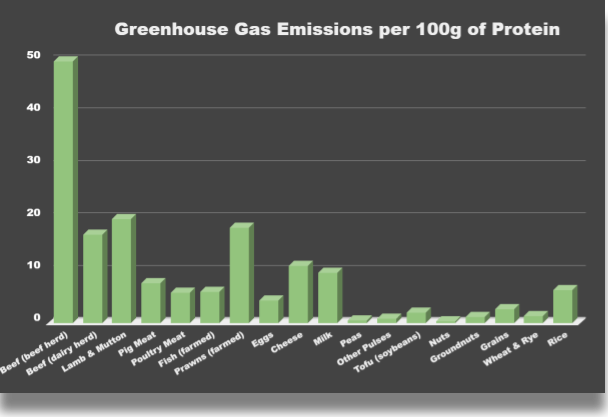CATEGORIES
Low Carbon Footprint Protein Sources - High Protein & Low Carbon Footprint Food
Jul 10,2021

We've all heard of a high protein-low carb diet right? But what if this were to mean a low carb..on (low carbon) footprint diet? Yes? Lame? Cool? You be the judge! Anyway, this article will be exploring the possibility for your diet to take into consideration the carbon footprint of your primary protein source. And with some environmentally friendly swaps, you can begin to reduce your diets carbon footprint without impacting on your protein needs.
Protein and the environment
Protein is an essential part of a healthy diet as it builds and repairs muscle tissue and bones, and is needed to synthesise hormones and enzymes. According to the Australian Dietary Guidelines (2013) (read more here), protein sources are recommended to come from primarily lean meat and poultry, fish, eggs, tofu, nuts and seeds, legumes/beans, and secondarily from milk, yoghurt, cheese and/or alternatives. Like most dietary guidelines worldwide, these recommendations take little or no consideration of how such protein sources may impact the environment. This lack of consideration is concerning, as a healthy environment good for us, the planet, and is essential in producing some of the foods mentioned above.
.
Therefore, choosing where your protein comes from regarding the environment, and not just from a health perspective, can have a major impact on your carbon footprint. Changing your dietary choices regarding protein and its carbon footprint can substantially reduce your diets overall carbon footprint. If you have considered switching towards environmentally friendly protein sources, keep reading.
Low carbon footprint protein
Low carbon footprint protein can come from many sources. Below is a graphic which can show in summary the amount of greenhouse gas emissions produced per 100g protein.
Figure 1: Greenhouse gas emissions of different protein sources.

(Source: Our World in Data: https://ourworldindata.org/grapher/ghg-per-protein-poore).
As you can see, there is a large difference in greenhouse gas emissions (GHG) depending on where you source your protein. For example, sourcing your daily protein needs from beef produces up to 50 kg of greenhouse gas emissions per 100 g of protein, as opposed to nuts (0.2 kg GHG / 100g protein), or tofu (2 kg GHG / 100g protein). In other words, obtaining 100 g of protein from beef, as opposed to nuts, produces 250 times more greenhouse gas emissions for the same 100 g of protein. From a general perspective, the graph shows that vegetable and even dairy sources of protein have a far lower carbon footprint than sources derived from meat. Does this mean you need to cut meat sources of protein out of your diet? Not necessarily. It only means that you should be mindful of where the majority of your protein comes from.
Where should you get low carbon footprint protein?
Since the data shows that plant protein sources, and to a lesser extent dairy sources, produce far less greenhouse gases per 100 g of protein produced than meat-based protein sources, non-meat based protein should be preferred. However, if you do choose to consume meat, fish and poultry make for a far more environmentally friendly option than beef, lamb or pork. When switching your protein sources to being plant based or more, it is important to select a wide variety of sources to ensure all 20 amino acids (9 of which are essential) used to synthesize protein in the human body are covered. This is not a difficult task, especially if you follow the recommended array of plant protein sources mentioned above in the Australian Dietary Guidelines (2013). This highlights the importance of having diverse dietary choices.
Whether you are a regular person or an elite athlete, it is possible to retrofit your protein needs with environmentally friendlier choices. By changing your primary source of protein, you can start to have an influence on your carbon footprint.
If you need help changing your dietary habits to one that is healthier and more environmentally friendly, check out our online tool here.
References.
1) Greenhouse gas emissions per 100 g of protein: “https://ourworldindata.org/grapher/ghg-per-protein-poore”.
2) Australian dietary guidelines (2018): “https://www.eatforhealth.gov.au/sites/default/files/content/The%20Guidelines/n55b_educator_guide_140321_1.pdf”.
